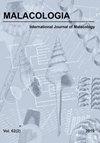Use of Native and Nonnative Fish Hosts by the Freshwater Mussel Anodonta californiensis (California Floater) in the Columbia River Basin
IF 1
4区 生物学
Q4 ZOOLOGY
引用次数: 0
Abstract
ABSTRACT Populations of many native freshwater mussels such as the California floater, Anodonta californiensis, are declining in the Columbia River Basin in the western United States. There are many possible reasons for this decline, including increased presence of nonnative fishes, especially piscivores that displace and reduce the abundance of native fishes. These nonnative fishes can negatively influence the early life history of A. californiensis, because this mussel uses native fishes to complete its life cycle. While Anodonta spp. can use nonnative fishes as hosts with limited success, the extent of this for A. californiensis is not well understood. We determined if the glochidia (larvae) of A. californiensis can successfully metamorphose using certain nonnative fishes, and we quantified differences in host effectiveness (number of juveniles produced) between native and nonnative fishes based on available fin area for attachment. Overall, native fishes hosted an average of 107.4 ± 39.9 (mean ± SE) juvenile mussels per fish while nonnative fishes hosted an average of 5.5 ± 4.9 juveniles per fish. This conclusion was unchanged when standardized for fish attachment area. Encystment of glochidia on native fishes yielded an average of 1.0 ± 0.1 juveniles/mm2 of attachable surface (total area of fins) area while nonnative fishes yielded an average of 0.16 ± 0.1 juveniles/mm2. The nonnative channel catfish, Ictalurus punctatus, did not yield any juvenile mussels and was identified as a nonhost species for A. californiensis. All other nonnative fishes tested were determined to be poor or marginal hosts. All native fishes were determined to be primary or secondary hosts for A. californiensis. The native fishes that yielded the highest number of juvenile mussels were sculpins, Cottus spp., and the redside shiner, Richardsonius balteatus, with an average of 196 and 151 juveniles per individual of each species, respectively. Our findings show that nonnative fishes are poor hosts for A. californiensis. However, nonnative fishes may contribute to the decline of native mussels in the Columbia River Basin by directly preying on and reducing the abundance of native host fishes and mussels. Future conservation plans for A. californiensis should consider the potential negative influence of nonnative fishes.哥伦比亚河流域淡水贻贝Anodonta californiensis(加利福尼亚漂浮物)对本地和非本地鱼类宿主的利用
摘要:在美国西部的哥伦比亚河流域,许多本地淡水贻贝的数量正在减少,如加利福尼亚浮游动物加利福尼亚无齿蚌。造成这种下降的原因有很多,包括非本地鱼类的增加,尤其是鱼类,它们取代并减少了本地鱼类的数量。这些非本地鱼类会对加州贻贝的早期生活史产生负面影响,因为这种贻贝使用本地鱼类来完成其生命周期。虽然Anodonta spp.可以使用非本地鱼类作为宿主,但成功率有限,但加州A.Californiansis的这种程度尚不清楚。我们确定了加利福尼亚A.californensis的球藻(幼虫)是否可以使用某些非本地鱼类成功变态,并根据可附着的鳍面积量化了本地和非本地鱼类之间宿主有效性(产生的幼体数量)的差异。总体而言,本地鱼类平均每条鱼有107.4±39.9(平均值±SE)个幼贻贝,而非本地鱼类平均每条鱼有5.5±4.9个幼贻。当对鱼类附着区域进行标准化时,这一结论没有改变。本地鱼类上的球壳虫平均产生1.0±0.1个幼体/mm2的可附着表面(鳍的总面积)面积,而非本地鱼类平均产生0.16±0.1个幼鱼/mm2。非本地渠道鲶鱼Ictalurus punctatus没有产下任何幼年贻贝,被确定为加利福尼亚a.Californiansis的非宿主物种。测试的所有其他非本地鱼类都被确定为贫穷或边缘宿主。所有本地鱼类都被确定为加利福尼亚A.californensis的初级或次级宿主。幼鱼贻贝数量最多的本地鱼类是双桨贻贝(Cottus spp.)和红鳍贻贝(Richardsonius balteatus),每个物种平均每个个体分别有196只和151只幼鱼。我们的发现表明,非本地鱼类是加利福尼亚A.californiensis的不良宿主。然而,非本地鱼类可能会直接捕食并减少本地宿主鱼类和贻贝的数量,从而导致哥伦比亚河流域本地贻贝的减少。加利福尼亚A.californensis未来的保护计划应该考虑外来鱼类的潜在负面影响。
本文章由计算机程序翻译,如有差异,请以英文原文为准。
求助全文
约1分钟内获得全文
求助全文
来源期刊

Malacologia
生物-动物学
CiteScore
2.00
自引率
0.00%
发文量
15
审稿时长
3 months
期刊介绍:
Malacologia publishes papers on all groups of the Mollusca. Malacologia specializes in publishing long papers and monographic treatments. Complete data are especially appreciated. Papers must be of interest to an international readership. Papers in systematics, ecology, population ecology, genetics, molecular genetics, evolution and phylogenetic treatments are especially welcomed. Also welcomed are letters to the editor involving papers published or issues of import to science of the day.
 求助内容:
求助内容: 应助结果提醒方式:
应助结果提醒方式:


